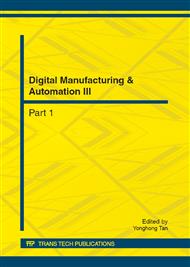[1]
A.A. Milenin, Simulation of metal forming during multi-pass rolling of shape bars, Journal of Materials Processing Technology 153–154 (2004) 108–114.
DOI: 10.1016/j.jmatprotec.2004.04.320
Google Scholar
[2]
Z. Pater, Theoretical and experimental analysis of cross wedge rolling process,International Journal of Machine Tools & Manufacture 40 (2000) 49–63.
DOI: 10.1016/s0890-6955(99)00047-4
Google Scholar
[3]
L.M. Galantucci, Thermo-mechanical simulation of a rolling process with an FEM approach, Journal of Materials Processing Technology 92–93 (1999) 494–501.
DOI: 10.1016/s0924-0136(99)00242-3
Google Scholar
[4]
Migule A.Cavaliere, Finite element analysis of steel rolling processes, Computers and Structures 79(2001) 2075-2089.
DOI: 10.1016/s0045-7949(01)00055-4
Google Scholar
[5]
K. Komori, Simulation of deformation and temperature in multi-pass caliber rolling, Journal of Materials Processing Technology 71 (1997) 329–336.
DOI: 10.1016/s0924-0136(97)00094-0
Google Scholar
[6]
Y.S. Kang, D.Y. Yang, A three dimensional finite element analysis of hot extrusion through square dies—automatic remeshing technique with modular concept, Eng. Comput. 14 (1997) 926–948.
DOI: 10.1108/02644409710192308
Google Scholar
[7]
J. Zhu, M. Gotoh, An automated process for 3D hexahedral mesh regeneration in metal forming, Comput. Mech. 24 (1999) 373–385.
DOI: 10.1007/s004660050458
Google Scholar
[8]
M.L. Alves, Finite element remeshing in metal forming using hexahedral elements, Journal of Materials Processing Technology 141 (2003) 395–403.
DOI: 10.1016/s0924-0136(03)00388-1
Google Scholar
[9]
A.O. Cifuentes, A. Kalbag, A performance study of tetrahedral and hexahedral elements in 3-D finite element structural analysis, FiniteElements Anal. Des. 12 (1992) 313–318.
DOI: 10.1016/0168-874x(92)90040-j
Google Scholar
[10]
T. M. Maccagno. J. J. Jonas, P. D. Hodgson. Spreadsheet Modeling of Grain Size Evolution during Rod Rolling [J], ISIJ International, 1996, 36 (6): 720-728.
DOI: 10.2355/isijinternational.36.720
Google Scholar
[11]
F. Siciliano, K. Minami, T. M. Maccagno, J. J. Jonas. Mathematical Modeling of Mean Flow Stress, Fractional Softening and Grain Size during the Hot Strip Rolling of C-Mn-Steels[J], ISIJ International, 1996, 36(12): 1500-1506.
DOI: 10.2355/isijinternational.36.1500
Google Scholar
[12]
K.P. Rao, Y.K.D.V. Prasad, E.B. Hawbolt. Hot Deformation Studies on Low-Carbon Steel: Part 1-Flow Curves and the Constitutive Relationship [J]. Journal of Materials Processing Technology, 1996, 56:897-907.
DOI: 10.1016/0924-0136(95)01902-2
Google Scholar
[13]
K.P. Rao, Y.K.D.V. Prasad, E.B. Hawbolt. Hot Deformation Studies on Low-Carbon Steel: Part 2-An Algorithm for the Flow Stress Determination under Varying Process Conditions [J]. Journal of Materials Processing Technology, 1996, 56:908-917.
DOI: 10.1016/0924-0136(95)01903-0
Google Scholar
[14]
F. G. Caballero, C. Capdevila, C. García de andrés. Modeling of Kinetics of Austenite Formation in Steels with Different Initial Microstructures [J], ISIJ International, 2001, 41(10): 1093-1102.
DOI: 10.2355/isijinternational.41.1093
Google Scholar
[15]
J.M. Cabrera, J. Ponce, J.M. Prado. Modeling thermomechanical processing of austenite [J]. Journal of Materials Processing Technology, 2003, 143: 403-409.
DOI: 10.1016/s0924-0136(03)00441-2
Google Scholar
[16]
P.D. Hodgson. Microstructure modeling for property prediction and control [J]. Journal of Materials Processing Technology, 1996, 60:27-33.
Google Scholar
[17]
J. Lin, T.A. Dean. Modeling of microstructure evolution in hot forming using unified constitutive equations [J]. Journal of Materials Processing Technology, 2005, 167:354-362.
DOI: 10.1016/j.jmatprotec.2005.06.026
Google Scholar
[18]
Y. Liu, J. Lin. Modeling of micro-structural evolution in multi-pass hot rolling [J]. Journal of Materials Processing Technology, 2003, 144:723-728.
Google Scholar
[19]
N. Bontcheva, G. Petzov .Total simulation model of the thermo-mechanical process [J]. Shape rolling of steel rods Computational Materials Science, 2005, 34:377-388.
DOI: 10.1016/j.commatsci.2005.01.009
Google Scholar
[20]
M. Glowacki. The mathematical modeling of thermo-mechanical processing of steel during multi-pass shape rolling [J]. Journal of Materials Processing Technology, 2005, 168:336-343.
DOI: 10.1016/j.jmatprotec.2004.12.007
Google Scholar


